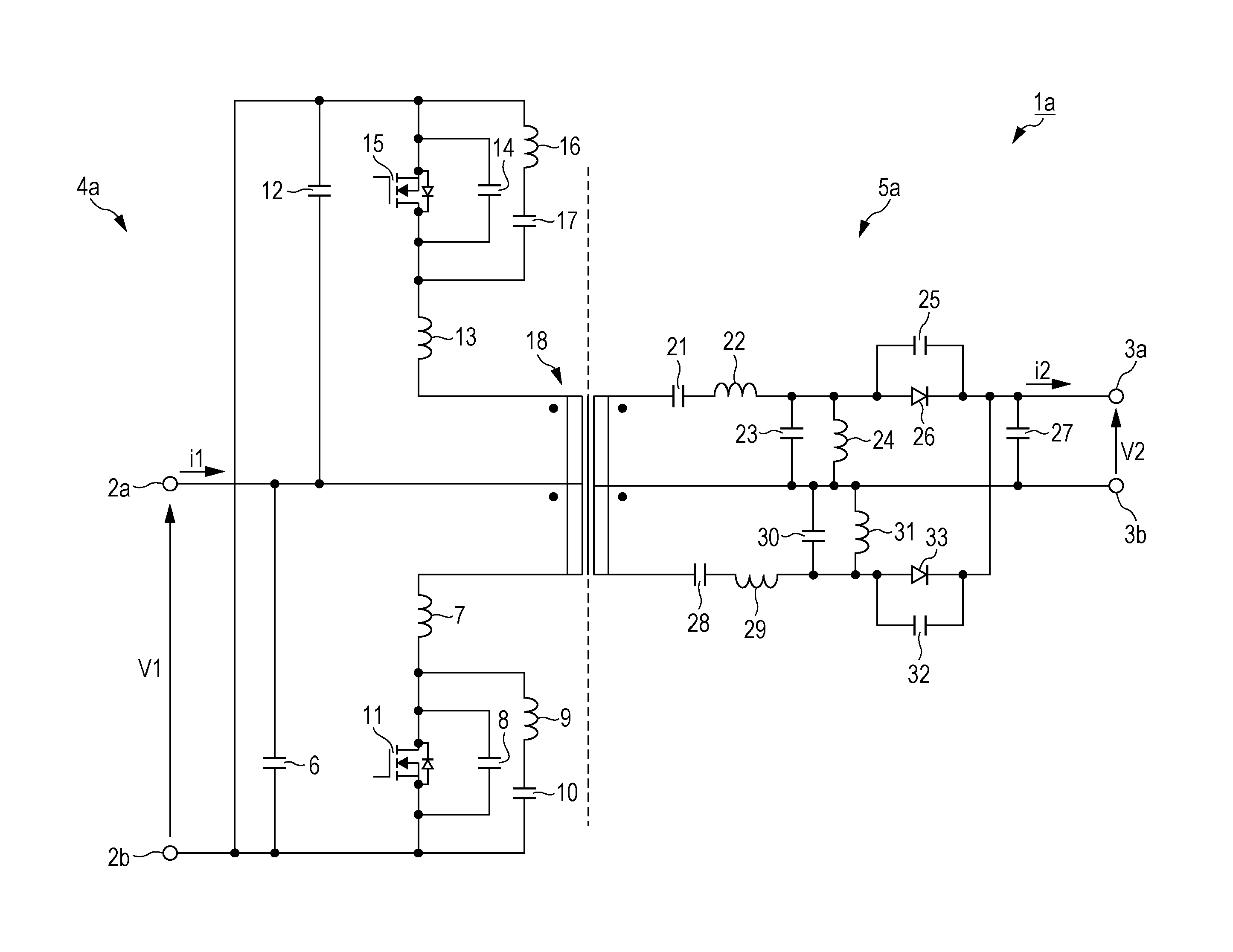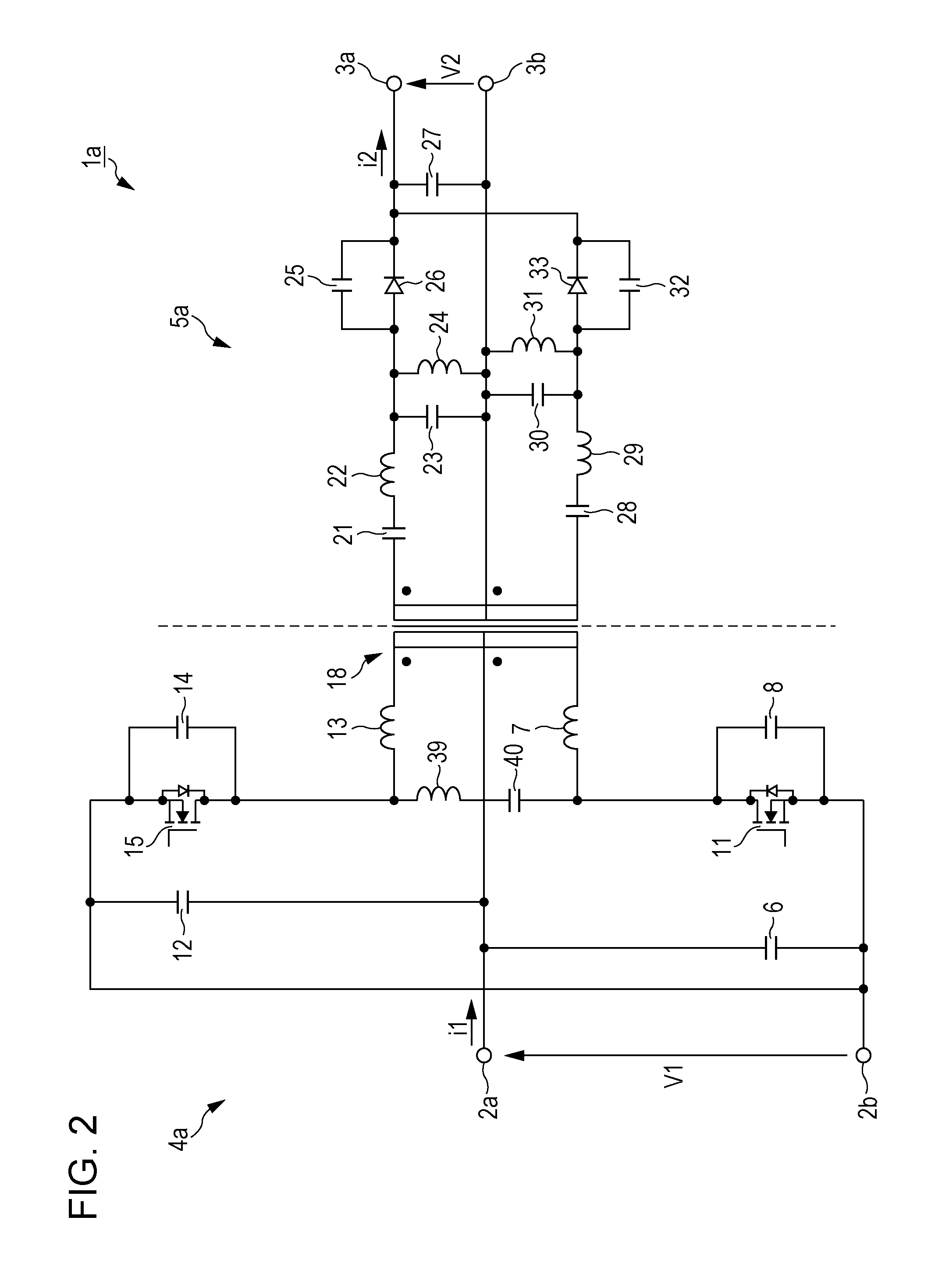Resonant inverter and isolated resonant power supply device
a power supply device and inverter technology, applied in the direction of electric variable regulation, process and machine control, instruments, etc., can solve the problems of difficult driving of high-side switches such as bridge circuits, large number of adjustment parts, and large voltage ranges, so as to reduce the operating voltage of the first switch or the second switch, the effect of reducing the cost of the circuit and the device, and prolonging the life of the switch
- Summary
- Abstract
- Description
- Claims
- Application Information
AI Technical Summary
Benefits of technology
Problems solved by technology
Method used
Image
Examples
first embodiment
[0028]FIG. 1 is a circuit diagram illustrating a configuration of a resonant converter 1a (isolated resonant power supply device) according to a first embodiment of the present invention. The resonant converter 1a illustrated in FIG. 1 includes a pair of input terminals, namely, a first input terminal 2a and a second input terminal 2b (hereinafter also collectively referred to as an input terminal 2 unless specifically referred to otherwise), a pair of output terminals, namely, a first output terminal 3a and a second output terminal 3b (hereinafter also collectively referred to as an output terminal 3 unless specifically referred to otherwise), a resonant inverter 4a, and a resonant rectifier 5a. The resonant converter 1a converts an input voltage (DC voltage) V1 input to the input terminal 2 into an output voltage (DC voltage) V2 and outputs the output voltage V2 from the output terminal 3. In the resonant converter 1a, the input voltage V1 and an input current i1 are input to the ...
second embodiment
[0078]FIG. 2 illustrates a resonant converter according to a second embodiment of the present invention. The second embodiment is different from the first embodiment in that, in the resonant inverter 4a, the third or fourth resonant circuit, based on which the second resonance frequency F2 is determined as described in the first embodiment, is configured by using a fifth resonant circuit. Specifically, in the first embodiment, the third resonant circuit constituted by the fourth coil 9 and the fourth capacitor 10 and the fourth resonant circuit constituted by the fifth coil 16 and the fifth capacitor 17 constitute the resonant circuit based on which the second resonance frequency F2 is determined. However, in the second embodiment, the fifth resonant circuit is constituted by a third coil 39 and a third capacitor 40 (third capacitive element). One end of the third capacitor 40 is connected to the other end of the first coil 7 and to one end of the first winding of the transformer 18...
third embodiment
[0079]FIG. 3 illustrates a resonant converter circuit according to a third embodiment of the present invention. The third embodiment is different from the second embodiment in that the first coil 7 and the second coil 13 are replaced by the leakage inductance of the transformer 18. The configuration of the remaining portion is the same as that of the second embodiment. One end of the first capacitor 8 is connected to the drain of the first switch 11, to one end of the third capacitor 40, and to one end of the first winding of the transformer 18. The other end of the first capacitor 8 is connected to the source of the first switch 11, to the input terminal 2b, and so on. One end of the second capacitor 14 is connected to the drain of the second switch 15, to one end of the third coil 39, and to one end of the second winding of the transformer 18. The other end of the second capacitor 14 is connected to the source of the second switch 15, to the input terminal 2b, and so on. In other ...
PUM
 Login to View More
Login to View More Abstract
Description
Claims
Application Information
 Login to View More
Login to View More - R&D
- Intellectual Property
- Life Sciences
- Materials
- Tech Scout
- Unparalleled Data Quality
- Higher Quality Content
- 60% Fewer Hallucinations
Browse by: Latest US Patents, China's latest patents, Technical Efficacy Thesaurus, Application Domain, Technology Topic, Popular Technical Reports.
© 2025 PatSnap. All rights reserved.Legal|Privacy policy|Modern Slavery Act Transparency Statement|Sitemap|About US| Contact US: help@patsnap.com



